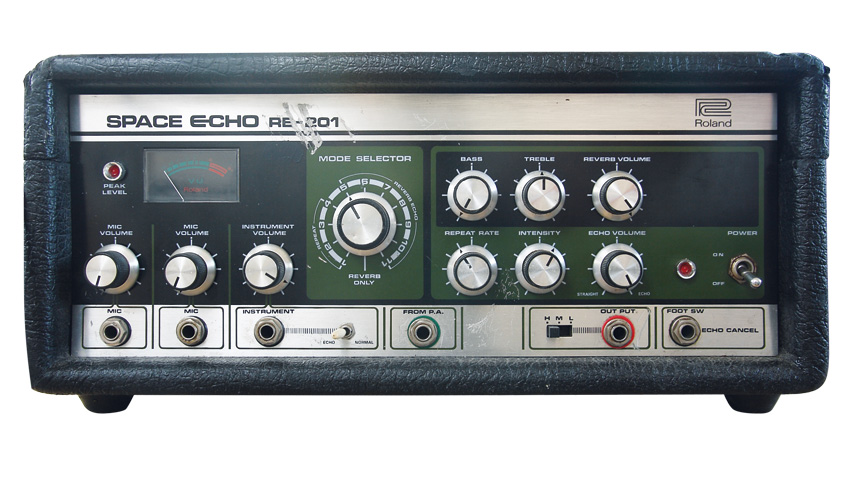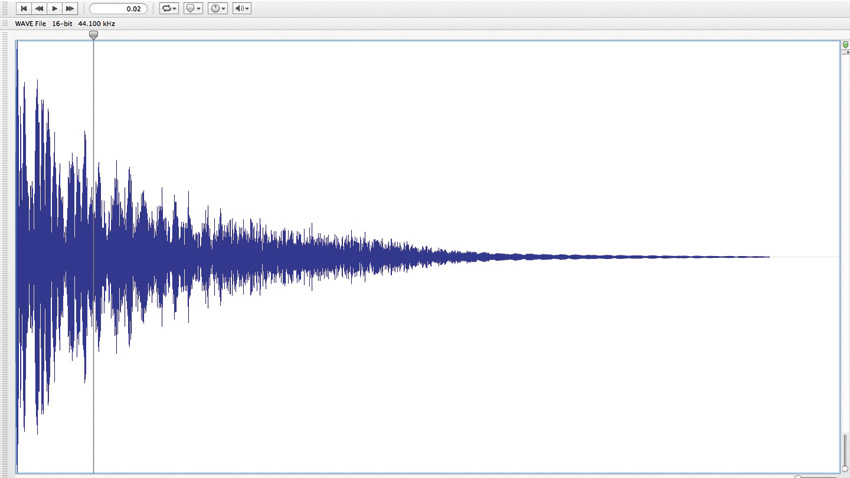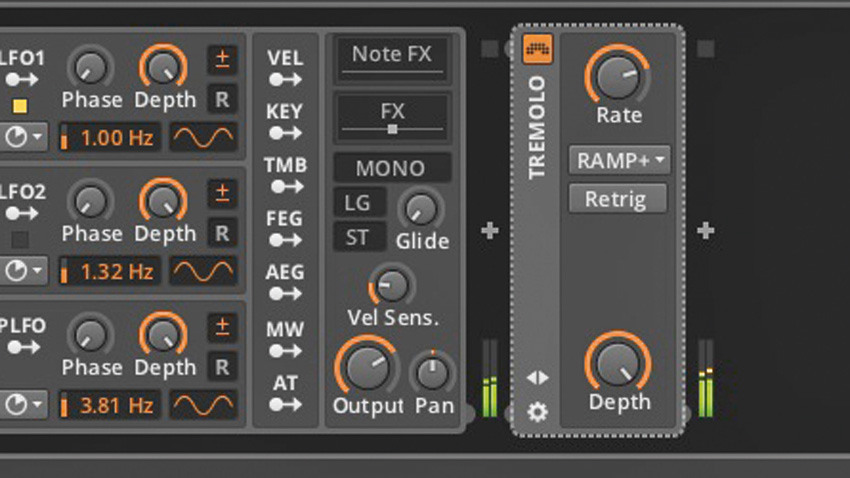The A to Z of computer music: T
Take a trip from 'tail' to 'tube'

Tune up on your terminology and teach yourself to talk tech, as we present another list of essentials for you to trawl through.
Tail
The late reflections of a reverb effect (ie, the main body of the sound after the very short early reflections) are also known as the tail, in reference to the fact that they 'tail off' to silence. The reverb tail can be shaped using a variety of controls including decay time, high- and low-frequency damping, and density.
Tap tempo
A feature of many software applications and hardware sequencers that enables the user to set the project tempo by clicking (or tapping) a dedicated button at the desired tempo. The minimum number of taps required to take a reading will usually be four, with further taps at the same tempo (given the relative looseness of human timing) refining the accuracy of the resulting BPM value.

Tape
Once the only practical recording medium available to the world's studios, analogue tape is now effectively dead (apart from use as a creative tool) thanks to the unstoppable rise of hard disk recording. Nevertheless, the hiss, background noise and saturation of tape are still seen as hugely desirable sonic qualities by many producers, resulting in the advent of tape emulation plugins such as u-he Satin and Slate Digital Virtual Tape Machines, which model all aspects of tape and tape machines, right down to wow and flutter, bias and crosstalk.

Tape delay
The original studio delay effect. The very earliest incarnation of tape delay involved simply looping an analogue tape recording, with the delay time adjusted by changing the length of the tape loop. However, tape delay as it's generally thought of today involves sending the signal to be processed to a tape machine with the repro head set up for monitoring, thus generating an echo, the timing of which is adjusted by changing the tape speed and/or the distance between the play and repro heads. Feedback can also be introduced by routing the tape machine's output back into its input.
While classic machines such as the Roland Space Echo, Watkins Copicat and EchoSonic are still sought after for their characteristic sound, there are plenty of superb tape delay plugins on the market for those who would rather save a small fortune and not have to deal with the many practical drawbacks of the real thing.
Tempo
The musical measurement of speed, described in BPM (beats per minute) but also expressed in 'classical' terms such as allegro (fast), adagio (slow) and rallentando (slowing down). With DJs requiring a level of tempo consistency from track to track in order to maintain coherence in their mixes, dance music is quite strict in terms of BPM. House music, for example, is usually at between 120 and 128bpm, drum 'n' bass is at 160-180bpm, and dubstep will almost always be at 140bpm. Tempo can be manipulated via automation in most DAWs, and upping the pace by 2-3bpm through a chorus can be a great way to inject a bit of energy.
Want all the hottest music and gear news, reviews, deals, features and more, direct to your inbox? Sign up here.
Threshold
In music production, a (usually user-specified) amplitude level in a dynamics processor above or below which the process in question is brought to bear. The most ubiquitous example is probably the threshold control on a compressor: when the input signal exceeds the set volume level, it's compressed. Similarly, the threshold on a gate effect establishes the volume level above which the gate is opened and below which it's closed.
Timbre
The tonal character of a sound, as defined by the combination of all of its components: frequency content over time, amplitude envelope, distortion, etc. Timbre might be verbalised as "dark", "rich", "warm", "smooth", "shiny" or any other evocative descriptor. In modern music production, the word is used most frequently in the discussion of synthesiser patches, but it can actually be applied to any musical sound.
Timestretch
A key technique in contemporary production, timestretching is exactly what the name suggests: the lengthening (slowing down) or shortening (speeding up) of an audio clip or sample. Today, timestretching is applied independently of pitchshifting, but in the early days of sampling (and prior to that, when 'timestretching' involved adjusting tape speed), speeding up or slowing down a sound necessarily involved pitching it up or down.
Modern timestretching algorithms are incredibly powerful, enabling adjustments of up to around 40bpm either way (depending on the source material) before the quality begins to suffer. The 'elastic audio' technologies now featured in pretty much every DAW employ 'segmented' timestretching to facilitate the precise positioning of sounds in a clip (drum hits, for example) on the timeline.
Timeline
The graded ruler running along the top edge of a DAW arrange page and its MIDI and audio editors that indicates when in time - in bars/beats, minutes/seconds, samples, or several other formats - the audio, MIDI and automation events that make up a project occur.
Track
As well as its non-technical usage to describe any piece of recorded music, the word 'track' refers to the individual 'lanes' in a DAW (or, back in the day, on a multitrack tape), onto which audio and MIDI parts are recorded or imported, edited, arranged and played back in parallel with all the other tracks in the project, the outputs of which are brought together in a mixer (either within the DAW or external).

Transient
The relatively loud and cutting initial attack of a sound - eg, the 'crack' of a snare drum, initial hammer strike of a piano key, or pluck of a guitar string. Many instruments - especially percussion - are defined in large part by their transients, and there are many transient-shaping plugins available that can be used to cut or boost them (and, separately, the sustained sound that follows), making them more or less punchy.
Transparency
When an effects processor (a compressor or EQ, say) is described as 'transparent', it usually means that it applies its process to an audio signal without colouring it in any way - ie, with all parameters set to neutral, the signal at the output will be identical (or very close to it) to the signal at the input. A plugin may also be described as transparent if the processing it applies results in no detectable artifacts or other audio 'clues' that the audio has in fact been altered. For instance, some EQs are designed to offer a definite 'sound' when boosting the bass, for example, perhaps even saturating the signal, whereas others are intended to raise the level of bass frequencies in as unobtrusive - ie, transparent - a manner as possible.
Transport
The transport section of a DAW or audio editor contains its playback and recording control buttons (Play, Record, Fast Forward, Reverse, etc), as well as numerical displays indicating the current playback position, cycle range, etc.
Transpose
The shifting of a MIDI note or audio clip up or down in pitch. Transposing audio is done by adjusting a knob or applying a pitchshifting plugin, while transposing MIDI notes can be done by moving the actual notes in a MIDI editor and/or applying a transposing MIDI plugin.

Tremolo
An audio effect that modulates the amplitude (volume) of the input signal using an LFO, the depth and speed of which can be adjusted.
Triangle wave
One of the 'standard' oscillator waveforms found in most analogue and virtual analogue synths, alongside the likes of sine, square and sawtooth. The triangle wave contains only odd harmonics and can be thought of as sitting between sine and square waves in terms of tone - harder than the former and softer than the latter - and thus serves as a good starting point for bass sounds as well as mellow leads and percussives.
Trigger
In order to elicit sound from a synth or sampler, it needs to be triggered. Triggering can be done by any MIDI source - keyboard, electronic drum kit, sequencer, etc - capable of sending the requisite data to the instrument: note volume, pitch and on/off timing. 'Trigger' also refers to transducer pickups attached to acoustic drumheads for - yep - triggering electronic percussion modules, samplers and synths, or alternatively, the process of using dedicated triggering software to achieve the same thing using mic'd recordings of drums.
Trim
Another name for a basic volume/gain control, typically used to set the input gain into a mixer channel for capturing an optimum signal level when recording. Nowadays, you might see trim knobs elsewhere, too - eg, in plugins.
Tube
Also known as a valve, a tube is a glass-encapsulated vacuum used as a voltage-controlled amplifier (electrons move freely in a vacuum) in mixers, mics and mic preamps, guitar amps and other audio gear, that imparts a characteristically warm sound, clipping and overdriving in a way that's considered more desirable and euphonic for many applications than its solid state transistor counterpart. Tubes are emulated in all kinds of software effects - indeed, there are plugins out there dedicated purely to virtualising valve preamps!
Computer Music magazine is the world’s best selling publication dedicated solely to making great music with your Mac or PC computer. Each issue it brings its lucky readers the best in cutting-edge tutorials, need-to-know, expert software reviews and even all the tools you actually need to make great music today, courtesy of our legendary CM Plugin Suite.
